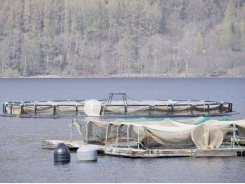Analyst: Salmon farming needs sector sea lice solutions to meet its full potential

Soaring global demand for farmed Atlantic salmon has put many of the sector’s producers in a very strong financial position in recent years, but greater gains are there for the taking if they can overcome biological production barriers, according to an aquaculture analyst.
Christian Nordby, equity research analyst at Kepler Cheuvreux, informed the recent Aquaculture Innovation Europe conference in London that the salmon market continues to grow at a rapid rate with demand surpassing the supply, and said farmers will remain in good stead as long as they don’t take the “unlikely” approach of creating oversupply in the market.
Europe provides the farmed salmon sector with its largest sales region, but the United States, with its population of almost 330 million, is the single-biggest market. It is also the fastest-growing market, and Nordby explained that all of the leading salmon producers have been investing in value-added product chains because they want to capitalize on the opportunities in the U.S. – a market where salmon consumers “strongly prefer” such products.
“In terms of salmon consumption per capita, the U.S. is now about 1.5 kilograms. But if it ever reached a consumption per capita of three kilograms, like France, then we will need a whole new Mowi in terms of size,” Nordby said. “There’s a lot of potential just in terms of America, but other markets are also growing rapidly. The China/Hong Kong market is, in my opinion, the most interesting because of the demand that’s coming over the next 10 years, particularly from a middle class of 300 to 400 million people … that market is huge. I was in China in the summer to look at the market and salmon was on the menu everywhere, particularly in Shanghai.”
Nordby said that a trade deal struck between China and Norway earlier this year has seen exports increase by around 25 percent, but for the next five years, the United States will remain the most important market for salmon farmers.
To meet the rising demand, and with no growth in the wild salmon harvest, the global supply of farmed Atlantic salmon has grown by 5.5 percent annually over the last 10 years, led by Norway and then Chile. Moving forward, he expects this rate of growth to be a bit slower – probably around 5.4 percent – as a result of the regulatory systems that are now in place. For example, the so-called “traffic light” system that divides Norway into 13 salmon farming zones is essentially capping the Scandinavian country’s biomass growth to 3 percent per year.
While land-based salmon farming systems offer some opportunity for increasing this output, the analyst believes that the most immediate route to greater growth is to increase the productivity of Norway’s existing farms.
“Obviously, farms want higher yields. This is where the money is heading into in the future,” Nordby said. “Most of the money will go to post-smolt systems and enhancements and the reason is that post-smolt will be the long-term productivity helper for the salmon farming industry.”
Solving the “extremely expensive” sea lice challenge is also key to productivity growth.
Norway’s annual spending on sea lice mitigation is estimated to be at least NOK 6 billion (USD 660 million, EUR 600.5 million). Nordby told delegates that “salmon farmers want solutions that fix their productivity problems.”
Currently, producers have two options when they get sea lice: They can either treat the fish or harvest them. But he highlighted that because, in recent times, Norwegian farmers have preferred to harvest earlier, the overall salmon harvest weight has steadily decreased.
“The question, as an industry, is how to get it up again because low harvest weight is extremely costly. You lose both in terms of the price premium associated with larger fish, and you also lose in terms of cost per kilograms," Nordby said.
Nordby acknowledged there is a “trade-off” in that the sea lice issues have exerted pressure on supplies and that this has caused prices to increase.
“It’s not all bad in terms of profits for the farmers, but they will still do anything that they can to fix this," he said.
Related news
Tools

Phối trộn thức ăn chăn nuôi

Pha dung dịch thủy canh

Định mức cho tôm ăn

Phối trộn phân bón NPK

Xác định tỷ lệ tôm sống

Chuyển đổi đơn vị phân bón

Xác định công suất sục khí

Chuyển đổi đơn vị tôm

Tính diện tích nhà kính

Tính thể tích ao



 Seafood exports expected to fetch US$10 billion: official
Seafood exports expected to fetch US$10 billion: official  Researchers testing feed premix effectiveness in sea lice…
Researchers testing feed premix effectiveness in sea lice…